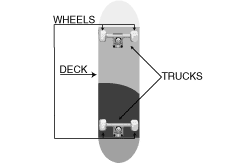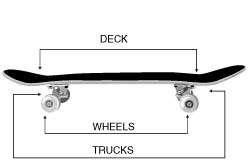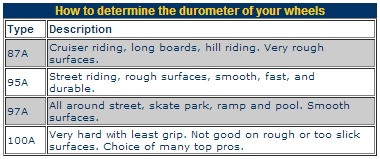Skateboards
There are several factors to consider when buying a complete board. Our guide takes you through the basics.
How to Buy A Skateboard
There is a lot more to a skateboard than meets the eye. That little piece of wood on four wheels is actually a highly technical piece of equipment comprised of many parts, all working together for the optimum ride. Your individual style of riding, budget, and terrain will dictate what type of skateboard and components are right for you.
Choosing the right skateboard
The best way to choose the proper skateboard is to know what role each of the various components plays.
How to buy the deck (board)
Physical characteristics
- Length
- There are two general length classifications of skateboard: Traditional/Street: under 33 in; and Longboard; over 35 in
- Traditional decks are the most common, and most versatile, while long boards are generally used for cruising only and provide the rider a very "surfy" feel
- Length choice is a purely personal decision, although a general rule states that smaller skaters should choose shorter boards (for control)
- Width
- Street decks range between 7.5 in and 8.25 in, although some decks are wider or narrower
- Width choice is also a purely personal decision, although smaller skaters (especially smaller footed skaters) will find a deck under 8 in makes it easier to learn tricks
- Concave
- Most decks (except for some longboards) have a raised nose, tail, and sides. This is called the concave.
- The depth and overall shape of the concave has a dramatic effect on the response of the skateboard to the skater
- The deeper the concave, the more aggressive the skater can be with their tricks
- The shallower the concave, the more forgiving the deck is for newer skaters
- Shape
- All of the above characteristics are commonly referred to as the deck shape
- While each characteristic plays a role in overall deck feel, it is the combination of all these factors from which a buying decision is made


Materials
- Wood
- The most common deck material is wood
- Almost all wood deck skateboards are made from Canadian Maple
- Each deck maker uses a varying number of plys (layers), usually no less than 5 and no more than 9
- Plastic
- Some less expensive skateboards utilize plastic for the deck. While this material is cheaper and more durable than wood, it does not offer the same responsivness.
- Other materials
- More recent materials of skateboard design include aluminum and fiberglass/carbon composites
- These materials are being used to try to improve upon the durability of wood, while maintaining its characteristics (pop/responsiveness)
How to buy trucks
Size
- Size is determined purely by deck width (although some skaters prefer certain truck widths)
- Most trucks range between 4.75 in and 5.5 in
- A slightly wider truck will offer a more stable landing platform and shorter turning radius, but is heavier
- Certain trucks can be found up to 7 in. This size truck is strictly used in conjunction with longboards.
Material
- Every truck is made from various versions of alloy metal (although some inexpensive skateboards use plastic)
- Increasingly, truck manufacturers are experimenting with space age metals in their alloy, like titanium
- The goal is to maintain the strength of the truck while reducing the weight
- Trucks also incorporate a bushing, which is the mechanism by which a truck turns. These bushings are available in varying degrees of hardness, which effect the ease by which a skateboard turns.
How to buy wheels
All skateboard wheels are made from polyurethane. However, the composition and color of skateboard wheels varies greatly.
Size
- Small/Street
- Most common skateboard wheels are between 52 mm and 60 mm
- Smaller riders might find the small wheels to be lighter and easier to control, however, wheel size is very much a rider preference item
- Large/Longboard
- Larger wheels (above 60 mm) are almost exclusive to longboards
- They are very fast and usually wider than smaller wheels

Hardness
- Hard/Street
- All street skateboard wheels are considerably hard. This hardness is rated in a measurement called durometer.
- Any wheel over 90a is considered hard
- The harder the wheels, the more pop a skater can get, but the harder they land
- Soft/Longboard
- Large wheels are also usually soft wheels (less than 90a durometer)
- The softness of these wheels creates a much smoother ride and offers more traction than a harder/smaller wheel
- These wheels are what allow a longboard skateboard to "surf" the earth
